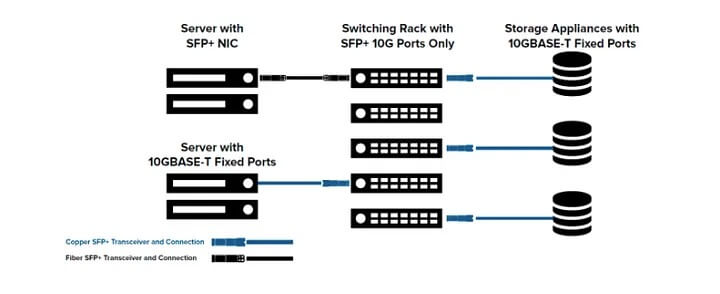10GBASE-T and 10G SFP+ DAC are both popular choices for short-reach copper cabling in data centers. But which one is superior? Which would you choose for your data center cabling? This article will delve into these matters and guide you toward a decision.
What is 10GBASE-T?
10GBASE-T, an IEEE802.a standard established in 2006, supports 10Gbps Ethernet networks using unshielded or shielded twinax cables (CAT6/CAT7), with distances of up to 30m achievable through CAT6 copper. It’s a result of the fourth-generation BASE-T technology within the IEEE standard. This technology combines the RJ45 connector with unshielded twisted pair copper cables to enable data transmission rates of 10Mbps, 100Mbps, 1Gbps, and 10Gbps while remaining compatible with previous generations.
Remarkably, this marks the advent of the first 10G SFP+ module with an RJ45 connector, capable of achieving speeds of up to 10Gb/s over copper cables. The 10G SFP+ copper transceiver adheres to the SFF-8431 and SFF-8432 MSA (Multi-Source Agreement) standards, designed specifically for high-speed network transmission based on 10G Ethernet.
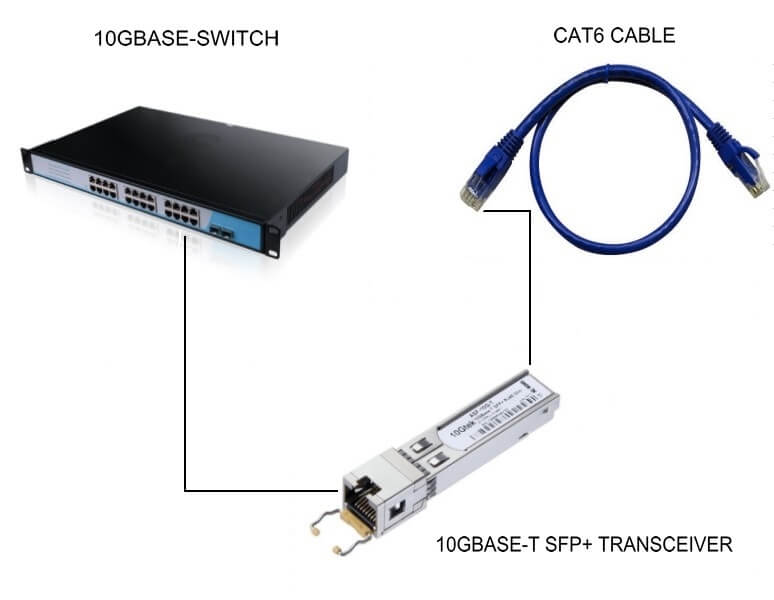
What is 10G SFP+ DAC?
The 10G SFP+ DAC utilizes copper interconnectivity through a Twinax cable assembly, connecting with the SFP+ housing. This technology serves as a cost-effective alternative to optical transceivers in Ethernet deployments, significantly reducing power consumption, latency, and installation time. Consequently, the 10G SFP+ DAC is the preferred choice for modern 10G networks that demand short distances and high speeds. With a limited transmission length of up to 12m, the SFP+ DAC is commonly employed for intra-rack and inter-rack connections. These connections include linking top-of-rack switches and servers, as well as establishing connections between storage devices within a single rack or neighboring racks.
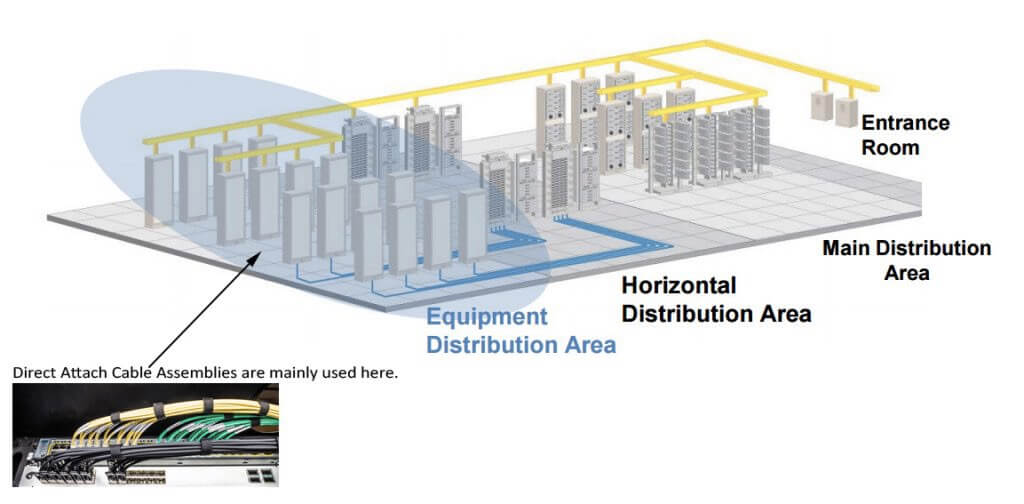
10GBASE-T vs SFP+ DAC: What Are Their Differences?
Now, we’ll examine the distinctions between 10GBASE-T cabling and SFP+ DAC Cable. The following figure outlines the specific differences between 10GBASE-T cabling and SFP+ DAC cable.
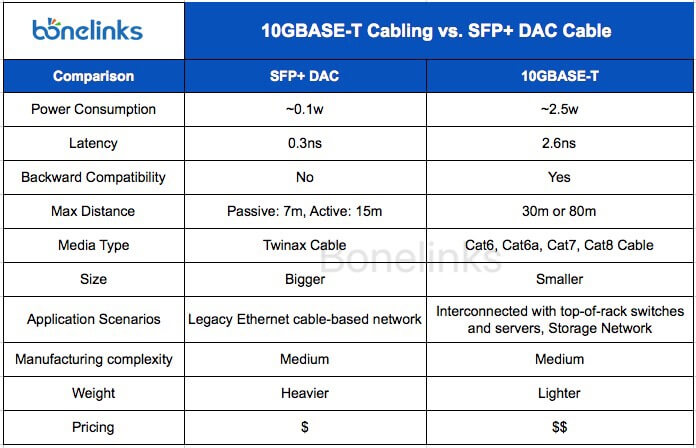
Cost
SFP+ components are currently priced at $20 per port or lower, offering affordability. Fiber cables are also cost-efficient, approaching the expenses of Cat 6a cables and decreasing as volume grows. Dropping prices of 10 gigabit SFP+ switches, NICs, and DACs contribute to an overall affordable solution.
On the other hand, 10GBase-T comes at a cost of approximately $50 to $100 per port. As the 40nm 10GBase-T enters mass production, costs are expected to decrease over time. Notably, 10GBase-T maintains backward compatibility with 1G ports, a feature utilized by many low-bandwidth devices. In the realm of small businesses, 10GBASE-T emerges as the more economical and user-friendly option for deployment when compared to the alternative SFP+ solution.
Latency
Achieving low latency is crucial to ensure rapid response times and minimize CPU idle cycles, ultimately enhancing data center efficiency and return on investment (ROI).
The 10GBase-T PHY standard employs block coding to facilitate error-free data transmission through the cable. This process involves reading the data block into the transmitter PHY, performing a mathematical function on the data, and transmitting the encoded data across the link. A similar process occurs at the receiving end. The standard mandates a transmit-receive pair latency of 2.6 microseconds, with an additional wait time of approximately 2.0 microseconds per link due to data block size.
In contrast, the SFP+ DAC cable utilizes simpler electronics that omit the need for code blocks. This results in a typical latency of around 300 nanoseconds per link. Therefore, SFP+ DAC offers lower latency compared to 10GBASE-T and SFP+ fiber cabling, which exhibit higher latency levels.
Distance
Utilizing the latest Cat 6A or Cat 7 cable enables 10GBase-T to span distances of up to 100 meters. The standard is engineered to accommodate the use of patch panels and patch cables, enhancing flexibility and ease of installation.
In contrast, the SFP+ DAC offers a maximum reach of 10 meters utilizing passive copper cables. Notably, DACs do not involve the use of patch panels in their setup.
Power Consumption
The 10GBASE-T solution exhibits significantly higher power consumption compared to SFP+ solutions, approximately three to four times more. The power usage of 10GBASE-T varies based on cable distance, ranging from 2 to 5 watts per port at each cable end. In contrast, SFP+ solutions maintain a consistent power consumption of approximately 0.7 watts per port, regardless of cable distance. This distinction is crucial, especially considering the extensive cable installations in a typical Datacenter. Opting for SFP+ can result in substantial cost savings and reduced operational complexities over the long term.
Backward Compatibility
10GBASE-T copper cabling boasts effective backward compatibility with standard copper network devices, offering optimal utilization of existing copper structured cabling. Leveraging the RJ45 connector, the 10GBase-T port can seamlessly interface with 1 gigabit and even 100 megabit interfaces. In contrast, DACs lack the versatility to connect to legacy equipment, exclusively catering to 10GbE switches. On the other hand, SFP 1 gigabit transceivers can be effortlessly inserted into SFP+ ports, functioning at 1 gigabit and facilitating connections to legacy ports via fiber cable. Furthermore, SFP modules that support 1GBase-T can also be inserted, enabling connections to legacy ports at slower speeds.
Application
10GBASE-T SFP+ modules find frequent application in wiring closets where they are integrated into switches and patch panels. This configuration facilitates connectivity to extensive clusters of desktop computers within a 100-meter range. In contrast, the advantages presented by SFP+ DACs align well with the needs of data centers and high-performance computing environments. These DACs are ideally suited for intra-cabinet connectivity within data centers, such as establishing links from servers to Top of Rack (ToR) switches spanning up to 10 meters. This includes interconnections between top-of-rack switches, servers, and storage devices within a single rack or between adjacent racks. Additionally, SFP+ modules are commonly deployed in campus Local Area Networks (LANs) to interconnect multiple buildings, often necessitating communication across greater distances.
10GBASE-T vs 10G SFP+ DAC: Advantages and Disadvantages
For small businesses prioritizing scalability and flexibility, 10GBASE-T cabling is the ideal choice. On the other hand, if power efficiency and reduced latency are crucial, 10G SFP+ cabling prevails. Both options have distinct advantages. Your network requirements will guide your selection.
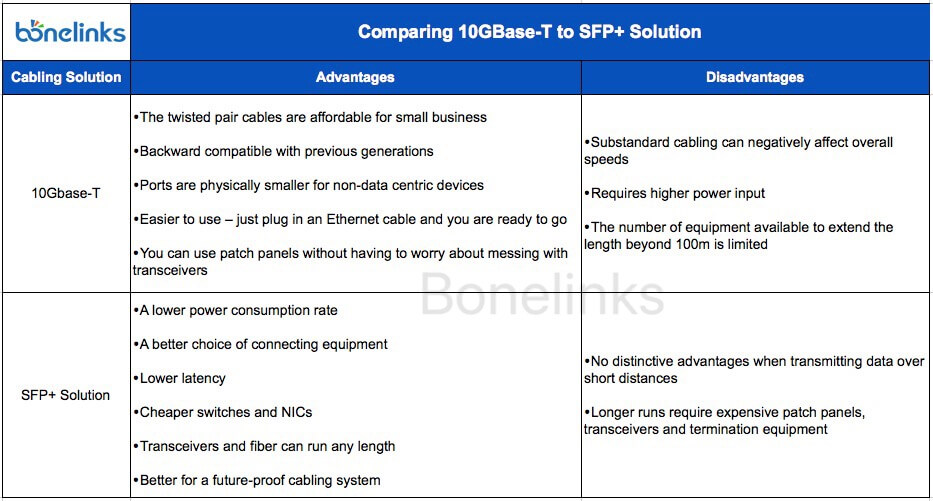
Conclusion
Generally, SFP+ copper cables are ideal for data centers, while 10GBASE-T cabling is better suited for wiring closets due to its flexibility and cost-effectiveness. By reading this post, you now have a clear understanding of 10GBASE-T and 10G SFP+ DAC. May it is helpful for your cabling.

